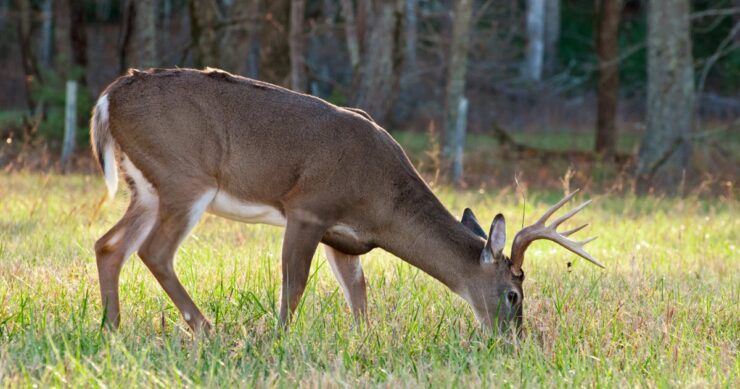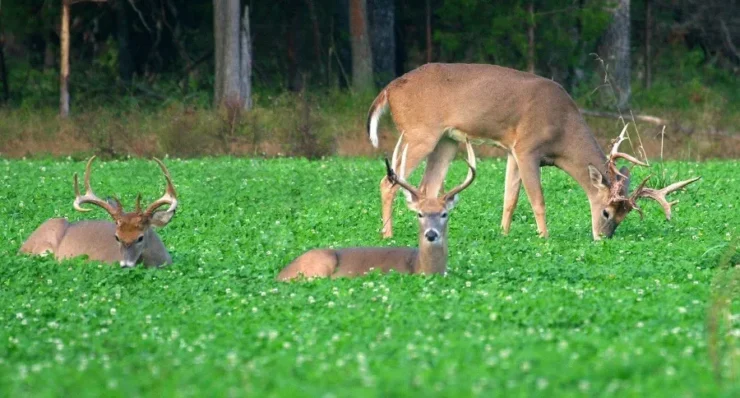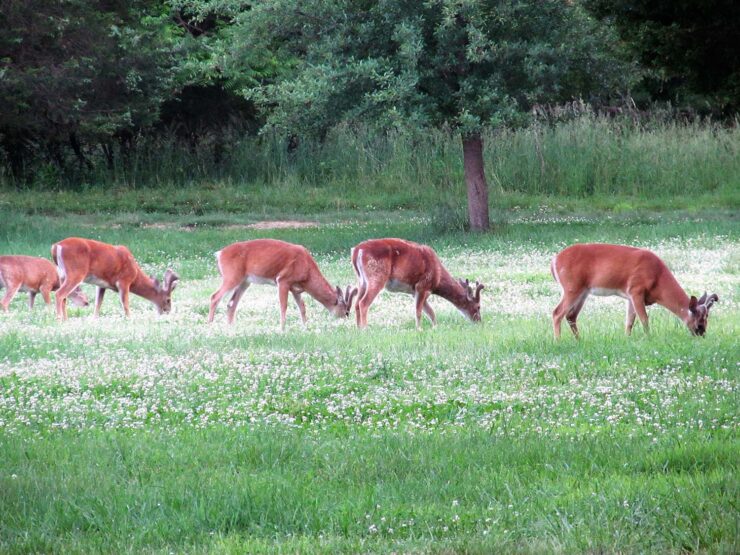The Buckshot Pea blend offers an agronomic-based response to excessive pre-season deer grazing while extending the longevity of the food plot.
The two questions most asked by those who grow white flower peas in their food plots is this: How do I keep the deer from devouring all my plants before opening day? And where can I get my hands on more of that crazy new deer candy?
In response Progene LLC, the developer of the original white flowered food plot peas, has released its new Buckshot Blend for 2011, a unique combination of spring and winter white flowered peas, which together, offer enhanced food plot survivability and longevity.
Mike Vose, owner and operator of Buck Fever Food Plots and Feed Products, Perry Illinois planted a single winter variety of white flowered peas in August 2009 to see what type of response he would get from the local whitetails he was hoping would honor him with a visit or two in the fall.
What occurred was far from that. Like shirt tail relatives the deer arrived for dinner early and stayed until every morsel was consumed. “By October first, when archery season opened up, the deer had grubbed the plot down to bare dirt,” he says adding that others who planted the peas suffered from a similar fate. “Those peas were just too tasty,”
In the spring of 2010, as a food plot cooperator with Progene LLC, Vose was one of the first to receive pre release planting samples of the new Buckshot Blend.
This gave Voss the opportunity to compare single variety plots with the new blend plots in 2010. “I put seven plots of the blend in on August 20,” he says. “What happened convinced me that planting a blend of white flowered peas is the approach we are going to have to take on dealing with this problem.”
Field Results Impressive

Vose explains that while most of the single winter variety white flowered pea plots had a significant setback from early deer grazing; the blend plots consisting of spring and winter white flowered pea varieties, under similar feeding pressure, not only continued to increase their biomass but in several instances, the spring peas in the blend managed to set flower and pod. “By October 1st those spring peas averaged 24 inches in height where the winter peas were around 12 inches,” he recalls. “The deer were really going after the spring peas partly because they were taller. This kept the grazing pressure off the shorter winter peas allowing them to establish themselves for the fall season”
The beauty of this pea blend is how well each plant performs in response to early grazing pressure says Vose. “The deer really do prefer the spring peas,” he says. “And those are the peas that can handle heavy grazing during the hot summer months.”
He notes that only after the spring peas are killed by a hard fall frost did the deer gradually shift their focus to the already established winter pea. That doesn’t mean they were any less enthusiastic about the winter peas once they tasted them says Vose.
Well into the winter months the deer chose to ignore the easily accessible standing corn and soy beans and instead, pawed up the surrounding snow so they could devour the remaining winter pea tendrils hidden below.
More Bang for Your Buck

The idea of combining the seed of two or more different plants to improve the overall performance of a crop is nothing new says Scott Marks of Connell Grain Growers, a Washington-State-based subsidiary of CHS. As the Sales Manager for a Cooperative that prides itself in providing the top performing seed to forage producers throughout the State, Marks is well aware of the dynamic role blends can play in achieving forage production goals. “Blends are very definitely an industry trend,” he says, adding that growers are using them to introduce qualities that might be lacking in single varieties. Deer walk through the other crops to eat the peas
He points out that as growers expect more out of their forage stands – whether it is higher yield, better nutritional value or even improved palatability – they are turning to blends to help achieve those results. “When you think about what you are trying to accomplish when you mix seeds it amounts to taking the best attributes out of each variety and trying to make a product that has the best features of all,” says Marks. “It can be an excellent way to introduce traits into a product without having to breed them into a single plant.”
With blends there is also a downside warns Marks. Not all plants are compatible. Their traits must compliment each other with one not out competing the other. “There must be a solid strategy behind blending seed. Each plant must offer a unique and needed trait to the whole so that the blend proves more effective at achieving the grower’s goals than any of its single contributors
He notes these criteria apply to all areas of forage production including food plots.
Strategy behind Buckshot
Kurt Braunwart, plant breeder and owner operator of Progene LLC views the blend of the two white flowered peas as an excellent example of a highly effective agronomic pairing. “Each plant contributes to the greater good of the stand,” he says. “We specifically selected them for that purpose.”
The problem that existed with planting white flowered winter peas by themselves, in high pressure areas, was survivability says Braunwart. “In locations with smaller deer populations and lower grazing intensity the white flowered winter peas were stellar performers,” he says. “But when they were hit night after night while they were trying to establish themselves stand survivability became an issue.”
He knew the problem lay in the characteristics common to all winter pea varieties. “Those peas are genetically programmed to sprout in the late summer, get established in the fall, survive the winter in a semi dormant state, recover their vigor in the spring and set flower and pod the next summer,” says Braunwart. “In order for them to do all that they do not use a lot of resources creating leaf mass in their early stages of development. Instead most of their initial energy goes into developing roots and the crown: two parts of the plant that must survive the winter in order for it to successfully complete its reproductive cycle.”
Braunwart adds that in contrast, white flowered spring peas have evolved as quick starters and vigorous growers because they must complete their reproductive cycle in the same year. “Unlike white flowered winter peas the white flowered spring peas only get one shot at producing seed,” he says. “They go all out like there is no tomorrow.”
Out of 15 possible varieties Braunwart and his research team selected Journey for the spring pea in the recommended Buckshot blend. “This is a particularly hardy variety of spring pea that is quick to establish and is most likely to withstand early deer predation,” he says.
For the winter pea component in the Buckshot Blend Braunwart has selected Frostmaster Nutrigreen or Whistler. “Both of these varieties display the traits best suited for food plot winter peas,” says Braunwart.

By combining Frostmaster Nutrigreen or Whistler white flowered winter pea with the Journey white flowered spring pea you get the best of both worlds says Braunwart. “With the buckshot blend you have a generous two course salad bar that runs from late summer through to the next spring,” he says. “First you serve white flowered spring peas then, just as the cold weather set in, out comes the white flowered winter peas,”
One hunter-bonus feature that exists in all three varieties is that they produce a smaller seed says Braunwart. “Smaller seed size to get more plants for each pound planted. That can be a real money saver when you put in a food plot.”
Coming to Your Food Plot this Year
It has come to ProgeneLLC’s attention that several prospective customers were unable to locate a source of white flowered peas in their area. In order to avoid this problem in the future please visit ProgeneLLC’s website at Progenellc.com to access a list of participating dealers in your area or you can call seedland.com at 888-820-2080 for another seed source.

